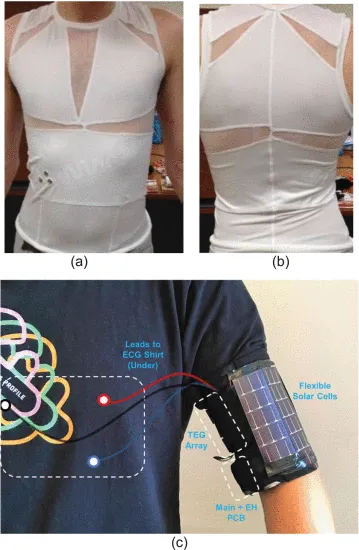Self-Powered Cardiac Monitoring: Maintaining Vigilance With Multi-Modal Harvesting and E-Textiles
Remote monitoring of patients with Cardiovascular Disease (CVD) is attempted to enable effective care of patients throughout the day and provide affordability and optimization of resources. Body sensor networks (BSN) play an essential role in collecting various kinds of accurate data in a continuous stream. User compliance and battery life are the two major obstacles to be addressed before utilizing the sensors for critical care cases.
Wearable sensors are classified based on active or passive engagement of patients, data storing or streaming, and continuous or intermittent acquisition mode of data. However, electrocardiogram (ECG) monitoring requires a state-of-the-art Atrial Fibrillation (AF) classification algorithm for a vigilant monitoring system so that it must not miss even a single critical event. Harvesting energy from natural resources such as solar energy and combining it with the thermoelectric energy harvested from body heat ensures the uninterrupted working of the self-powered sensor system by providing continuous power with light or in its absence.
Overcoming all the potential obstacles, especially user compliance and battery life, a wearable self-powered sensor system with textile integration is proposed, which can be used for vigilant cardiac and active monitoring of the body. It generates its positive energy balance from thermal and indoor solar energy, eliminating the issue of battery life. In addition, the system is integrated with a smartphone to analyze and display the data to the user in a readable format. Also, it enables remote data access and notification to the caregiver/clinic.
The architecture has three modules. The Sensor blocks collect the data from the user wearing the sensor and store it in a buffer on the system-on-chip for transmission. The Control and Data Transmission block controls the sensor data flow and wirelessly transmits it to the smartphone. The Energy Harvesting and Power Management block generates power and provides it to the other two blocks.
A custom-made ECG shirt and energy harvesting garments were made to improvise user compliance and system wearability. A garment with an upper armband was introduced wherein multiple flexible films of solar cells were sewed on the anterior of the band to capture solar energy during the day. Thermoelectric Generators (TEGs) were attached to the interior of the band to generate energy from the body's heat under little or no-light conditions. The garment generated enough power to be kept operational round-the-clock. The excess energy, if produced, is stored in a supercapacitor to be used when needed.
For preparing an ECG shirt, three dry electrodes were integrated into the compression fabric of the shirt. The shirt's fabric was carefully chosen so that the electrodes stay close to the body. Using higher elastic fabric isolates the noise caused by the undesired body-motion artifacts such as running or dancing from the electrodes. Dryness of the electrodes does not irritate the body and allows long term data collection. But wrinkles in cloth and dry skin of patient can affect the quality of ECG signals. It was resolved by using lotion near electrodes.
Keeping low sampling rate ensures less energy consumption but it may miss some important features of the ECG signal. 50 Hz was found to be the minimum sampling rate for vigilant AF monitoring. The ECG signal analysis resolution was fixed at 8 bits for quality of AF detection. The system consumed 680 µW on average for these two settings which is adequately produced by the wearable system designed.
This system, when compared with other state-of-the-art systems, carries advantages in lower power consumption, vigilant and continuous operation and end-to-end system integration for remote monitoring.




